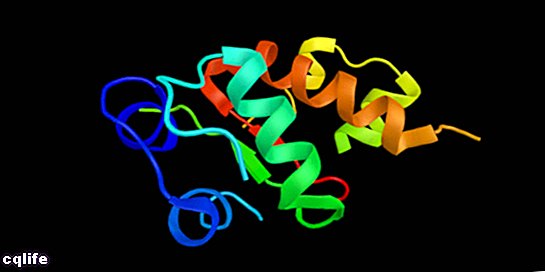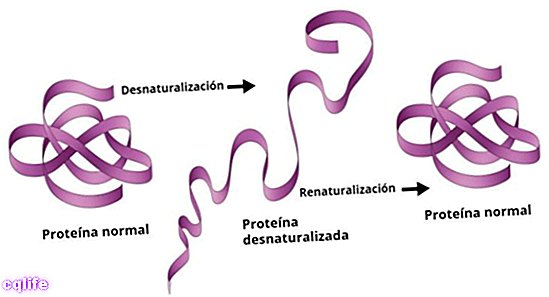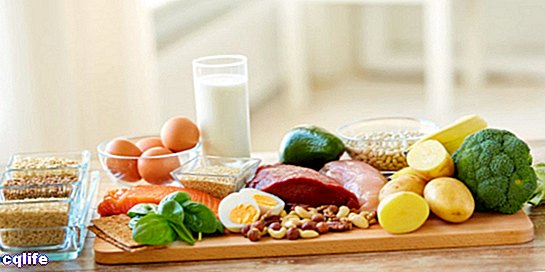- What is Protein?
- Protein types
- What do proteins serve for?
- Structural levels of proteins
- High protein foods
We explain what proteins are and the types of proteins that exist. What are they for, their structural levels and food.

What is Protein?
Proteins are macromolecules made up of structural units called amino acids. They always contain carbon, oxygen, nitrogen, hydrogen, and often sulfur as well.
Amino acids are molecules organic compounds composed of an amino functional group (-NH2) at one end and a carboxyl functional group (-COOH) at the other end. There are twenty fundamental amino acids, which in different combinations, constitute the basis of proteins. Two examples of amino acids are alanine and cysteine:
To form proteins, amino acids are linked together by peptide bonds, that is, the union of the end with the amino functional group (-NH2) of one amino acid, with the end containing the carboxyl functional group (-COOH) of another amino acid. Thus, amino acids are linked in different combinations and as many times as necessary, until each specific protein is formed. An example of how the peptide bond is formed can be seen in the following figure, where alanine is represented in color pink, the cysteine in red, and the peptide bond in blue:
Protein types

Proteins are very important for the body, since they participate in all the processes performing. They can be classified according to:
- Its chemical composition:
- Its three-dimensional shape (distribution in space of its structure):
- Fibrous proteins. Their structure is in the form of long fibers and they are insoluble in Water.
- Globular proteins. Their structure is rolled up and compact, with an almost spherical shape and they are usually soluble in water.
What do proteins serve for?
Proteins are essential for the human body and its growth. Some of its functions are:
- Structural. Many proteins are responsible for giving shape, elasticity and support to the cells and, therefore, to the tissues. For example: collagen, elastin and tubulin.
- Immunological. Antibodies are proteins that act as a defense against external agents or infections that affect the human body and the animals.
- Motorboat. Myosin and actin are proteins that allow the movement. In addition, myosin is part of the contractile ring in cell division, allowing cytokinesis (separation of cells by strangulation).
- Enzymatic. Some proteins accelerate certain metabolic processes. Some examples of enzyme proteins are pepsin and sucrase.
- Homeostatics. Homeostasis is the maintenance of internal balance in organisms. Proteins with homeostatic function, together with other regulatory systems, maintain the regulation of the pH of these organisms.
- Booking. Many proteins are a source of energy and carbon for many organisms. For example: casein and ovalbumin.
Structural levels of proteins

When a protein loses any of its structural levels, it becomes denatured.
The structure of a protein can be classified into various levels of organization and distribution of the units that compose it, according to:
- Primary structure. It is the sequence of amino acids that make up a protein (it refers only to the types of amino acids that make up its structure and the order in which they are linked).
- Secondary structure. Describe the local orientation of the different segments that make up a protein. In general, although there are other types, the main ones are: Alpha helix (it is a segment with a spiral-shaped structure on itself) and Folded beta sheet (it is a segment with a stretched and folded shape, similar to an accordion). The forms of both segments are generated and stabilized mainly by hydrogen bonding interactions.
- Tertiary structure. It consists of the arrangement in space of the secondary structure, which can be molded to form globular or fibrous proteins. The tertiary structure is stabilized by Van der Waals interactions, by disulfide bridges between sulfur-containing amino acids, by hydrophobic forces, and by interactions between amino acid radicals.
- Quaternary structure. It is formed by the union of several peptide segments, that is, it is composed of the union of several proteins. Proteins with a quaternary structure are also called oligomeric proteins and do not make up the majority of proteins. This structure is stabilized by the same type of interactions that stabilize the tertiary structure.
When proteins are subjected to high temperatures, to drastic changes in pH, to the action of some organic solvents, among other factors, they become denatured. Denaturation is the loss of the secondary, tertiary and quaternary structures, which leaves the polypeptide chain without any fixed three-dimensional structure, it could be said, it is reduced to its primary structure. If the protein recovers these structures (returns to its original form) then it renatures itself. The following image represents the different structures of a protein:

High protein foods

The food Rich in protein, they are recommended for a healthy diet and in high protein amounts. The shakes provide a large part of the daily protein source that is recommended to ingest.
There are two types of protein-rich foods, those of plant origin and those of animal origin. High protein animal foods include eggs, fish, dairy products, and red and white meats. Nuts, soybeans, cereals and legumes are high-protein foods of plant origin.
